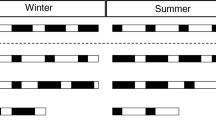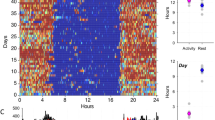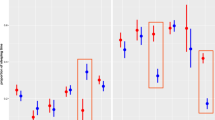Abstract
Sleep in the primate order remains understudied, with quantitative estimates of sleep duration available for less than 10% of primate species. Even fewer species have had their sleep synchronously quantified with meteorological data, which have been shown to influence sleep–wake regulatory behaviors. We report the first sleep duration estimates in two captive gibbon species, the Javan gibbon (Hylobates moloch) and the pileated gibbon (Hylobates pileatus) (N = 52 nights). We also investigated how wind speed, humidity, temperature, lunar phase, and illumination from moonlight influence sleep–wake regulation, including sleep duration, sleep fragmentation, and sleep efficiency. Gibbons exhibited strict diurnal behavior with little nighttime activity and mean total average sleep duration of 11 h and 53 min for Hylobates moloch and 12 h and 29 min for Hylobates pileatus. Gibbons had notably high sleep efficiency (i.e., time score asleep divided by the time they spent in their sleeping site, mean of 98.3%). We found illumination from moonlight in relation to lunar phase and amount of wind speed to be the strongest predictors of sleep duration and high-quality sleep, with increased moonlight and increased wind causing more fragmentation and less sleep efficiency. We conclude that arousal threshold is sensitive to nighttime illumination and wind speed. Sensitivity to wind speed may reflect adaptations to counter the risk of falling during arboreal sleep.




Similar content being viewed by others
References
Adams PM, Barratt ES (1974) Nocturnal sleep in squirrel monkeys. Electroencephalogr Clin Neurophysiol 36:201–204
Adey WR, Kado RT, Rhodes JM (1963) Sleep: cortical and subcortical recordings in the chimpanzee. Science 141(3584):932–933
Ahsan MF (2001) Socio-ecology of the hoolock gibbon (Hylobates hoolock) in two forests of Bangladesh. In: The apes: challenges for 21st century. Brookfield Zoo, 286–299
Ancoli-Israel S, Cole R, Alessi C, Chambers M, Moorcroft W, Pollak CP (2003) The role of actigraphy in the study of sleep and circadian rhythms. Sleep 26(3):342–392
Andersen ML, Diaz MP, Murnane KS, Howell LL (2013) Effects of methamphetamine self-administration on actigraphy-based sleep parameters in rhesus monkeys. Psychopharmacology 227:101–107
Anderson JR (1998) Sleep, sleeping sites, and sleep-related activities: awakening to their significance. Am J Primatol 46(1):63–75
Anderson JR, McGrew WC (1984) Guinea baboons (Papio papio) at a sleeping site. Am J Primatol 6(1):1–14
Anderson JR, Ang MY, Lock LC, Weiche I (2019) Nesting, sleeping, and nighttime behaviors in wild and captive great apes. Primates 60(4):321–323
Ayers AM, Allan ATL, Howlett C, Tordiffe ASW, Williams KS, Williams ST, Hill RA (2020) Illuminating movement? Nocturnal activity patterns in chacma baboons. J Zool 310(4):287–297
Barrett CE, Noble P, Hanson E, Pine DS, Winslow JT, Nelson EE (2009) Early adverse rearing experiences alter sleep–wake patterns and plasma cortisol levels in juvenile rhesus monkeys. Psycho Neuroendocrinology 34:1029–1040
Bartoń K (2014) MuMIn: Multi-model inference. Available from: http://CRAN.R-project.org/package=MuMIn.
Bartoń K (2015) Version 1.15.6 ed, https://cran.r-project.org/web/packages/MuMIn.
Bonnet MH, Arand DL (2003) Clinical effects of sleep fragmentation versus sleep deprivation. Sleep Med Rev 7(4):297–310
Bray J, Samson DR, Nunn CL (2017) Activity patterns in seven captive lemur species: Evidence of cathemerality in Varecia and Lemur catta? Am J Primatol 79(6):e22648
Campbell SS, Tobler I (1984) Animal sleep: A review of sleep duration across phylogeny. Neurosci Biobehav Rev 8:269–300
Capellini I, Barton RA, McNamara P, Preston BT, Nunn CL (2008) Phylogenetic analysis of the ecology and evolution of mammalian sleep. Evolut: Int J Org Evolut 62(7):1764–1776
Cheyne SM, Höing A, Rinear J, Sheeran LK (2013) Sleeping site selection by agile gibbons: the influence of tree stability, fruit availability, and predation risk. Folia Primatol 89(36):299311. https://doi.org/10.1159/000342145
Chivers DJ (1974) The siamang in Malaya: a field study of a primate in a tropical forest. Contr Primatol 4:1–335
Chivers DJ (1975) Daily patterns of ranging and feeding in siamang. In: Kondo S, Kawai M, Ehara A (eds) Contemporary primatology, proceedings of the 5th international congress of primatology. Karger, Basel, pp 362–372
Clarke E, Reichard UH, Zuberbühler K (2012) The anti-predator behaviour of wild white-handed gibbons (Hylobates lar). Behav Ecol Sociobiol 66(1):85–96
Curtis DJ, Rasmussen MA (2006) The evolution of cathemerality in primates and other mammals: a comparative and chronoecological approach. Folia Primatol 77(1–2):178–193
Dooley HM, Judge DS (2015) Kloss gibbon (Hylobates klossii) behavior facilitates the avoidance of human predation in the Peleonan forest, Siberut Island, Indonesia. Am J Primatol 77(3):296–308
Eppley TM, Ganzhorn JU, Donati G (2015) Cathemerality in a small, folivorous primate: proximate control of diel activity in Hapalemur meridionalis. Behav Ecol Sociobiol 69(6):991–1002
Erkert HG, Kappeler PM (2004) Arrived in the light: diel and seasonal activity patterns in wild Verreaux’s sifakas (Propithecus v. verreauxi; Primates: Indriidae). Behav Ecol Sociobiol 57(2):174–186
Fallows C, Fallows M, Hammerschlag N (2016) Effects of lunar phase on predator-prey interactions between white shark (Carcharodon carcharias) and Cape fur seals (Arctocephalus pusillus pusillus). Environ Biol Fishes 99(11):805–812
Fan P, Ni Q, Sun G, Huang B, Jiang X (2009) Gibbons under seasonal stress: the diet of the black crested gibbon (Nomascus concolor) on Mt. Wuliang, Central Yunnan, China. Primates 50(1):37
Fei HL, Scott MB, Zhang W, Ma CY, Xiang ZF, Fan PF (2012) Sleeping tree selection of cao vit gibbon (Nomascus nasutus) living in degraded Karst Forest in Bangliang, Jingxi, China. Am J Primatol 74(11):998–1005
Fei HL, Zhang D, Yuan SD, Zhang L, Fan PF (2017) Antipredation sleeping behavior of skywalker hoolock gibbons (Hoolock tianxing) in Mt. Gaoligong, Yunnan, China. Int J Primatol 38(4):629–641
Fei HL, Thompson C, Fan PF (2019) Effects of cold weather on the sleeping behavior of Skywalker hoolock gibbons (Hoolock tianxing) in seasonal montane forest. Am J Primatol 81(9):e23049
Fernández-Duque E, De La Iglesia H, Erkert HG (2010) Moonstruck primates: owl monkeys (Aotus) need moonlight for nocturnal activity in their natural environment. PLoS ONE 5(9):e12572
Franken P, Dijk D, Tobler I, Borbely AA (1991) Sleep deprivation in rats: effects on EEG power spectra, vigilance states, and cortical temperature. Am J Physiol-Regul 261:0198–0208
Freemon FR, Walter RD (1970) Electrical activity of human limbic system during sleep. Compr Psychiatry 11(6):544–551
Freemon FR, McNew JJ, Adey WR (1969) Sleep of unrestrained chimpanzee: cortical and subcortical recordings. Exp Neurol 25(1):129–137
Freemon FR, McNew JJ, Adey WR (1971) Chimpanzee sleep stages. Electroencephalogr Clin Neurophysiol 31(5):485–489
Fruth B, Tagg N, Stewart F (2018) Sleep and nesting behavior in primates: a review. Am J Phys Anthropol 166(3):499–509
Geissmann T, Nijman V, Dallmann R (2006) The fate of diurnal primates in southern Sumatra. Gibbon Journal 2:18–24
Gittins SP (1982) Feeding and ranging in the agile gibbon. Folia Primatol 38(1–2):39–71
Hartse K (2011) The phylogeny of sleep. In: Montagna P, Chokroverty S (eds) Handbook of clinical neurology. Elsevier B.V, New York, pp 97–109
Havercamp K, Morimura N, Hirata S (2021) Sleep patterns of aging Chimpanzees (Pan troglodytes). Intern J Primatol 42(1):89–104
Healey JF (2009) Statistics: a tool for social research. Thomson/Wadsworth, Belmont, CA
Johnson NL, Kirchner HL, Rosen CL, Storfer-Isser A, Cartar LN, Ancoli-Israel S, Redline S (2007) Sleep estimation using wrist actigraphy in adolescents with and without sleep disordered breathing: a comparison of three data modes. Sleep 30(7):899–905
Kantha SS, Suzuki J (2006) Sleep quantitation in common marmoset, cotton top tamarin and squirrel monkey by non-invasive actigraphy. Comp Biochem Physiol A: Mol Integr Physiol 144(2):203–210
Kappeler PM, Erkert HG (2003) On the move around the clock: correlates and determinants of cathemeral activity in wild redfronted lemurs (Eulemur fulvus rufus). Behav Ecol Sociobiol 54(4):359–369
Kavanau JL (2005) Evolutionary approaches to understanding sleep. Sleep Med Rev 9(2):141–152
Kawada T (2013) Sleep parameters in rhesus monkeys by using actigraphy. Psychopharmacol 228:509–509
Kronfeld-Schor N, Dominoni D, De la Iglesia H, Levy O, Herzog ED, Dayan T, Helfrich-Forster C (2013) Chronobiology by moonlight. Proc Royal Soc B: Biol Sci 280(1765):20123088
Lammers AR, Zurcher U (2011) Stability during arboreal locomotion. Theoretical biomechanics 319–334.
Landis CA, Robinson CR, Levine JD (1988) Sleep fragmentation in the arthritic rat. Pain 34(1):93–99
Lesku JA, Roth TC, Amlaner CJ, Lima SL (2006) A phylogenetic analysis of sleep architecture in mammals: the integration of anatomy, physiology, and ecology. Am Nat 168:441–453
Maples WR, Maples MK, Greenhood WF, Walek ML (1976) Adaptations of crop-raiding baboons in Kenya. Am J Phys Anthropol 45(2):309–315
Marks GA, Shaffery JP, Oksenberg A, Speciale SG, Roffwarg HP (1995) A functional role for REM sleep in brain maturation. Behav Brain Res 69(1–2):1–11
McElreath R (2019) Statistical rethinking: a Bayesian course with examples in R and Stan. Chapman and Hall/CRC
McNamara P, Auerbach S (2010) Evolutionary medicine of sleep disorders: toward a science of sleep duration. In: McNamara P, Barton RA, Nunn CL (eds) Evolution of sleep: phylogenetic and functional perspectives. Cambridge University Press, Cambridge, pp 107–122
Melvin E, Samson D, Nunn CL (2019) Eulerian videography technology improves classification of sleep architecture in primates. Primates 60(5):467–475
Mezick EJ, Matthews KA, Hall M, Kamarck TW, Buysse DJ, Owens JF, Reis SE (2009) Intra-individual variability in sleep duration and fragmentation: associations with stress. Psychoneuroendocrinology 34(9):1346–1354
Moffitt JD (1977) The effects of meteorological variables on certain sleep characteristics. In: Doctoral dissertation, University of the Pacific
Muñoz-Delgado J, Corsi-Cabrera M. (2010) Chronoecology of neotropical primates: the spider monkey Ateles geoffroyi. Biological Clocks: Effects on Behavior, Health And Outlook, 139.
Nunn CL (2011) The comparative approach in evolutionary anthropology and biology. The University of Chicago Press, Chicago and London
Nunn CL, Samson DR (2018) Sleep in a comparative context: investigating how human sleep differs from sleep in other primates. Am J Phys Anthropol 166(3):601–612
Nunn CL, McNamara P, Capellini I, Preston BT, Barton RA (2010) Primate sleep in phylogenetic perspective. Evolution of sleep: Phylogenetic and functional perspectives, 123–145.
Preston BT, Capellini I, McNamara P, Barton RA, Nunn CL (2009) Parasite resistance and the adaptive significance of sleep. BMC Evol Biol 9:7
Preuschoft H (2002) What does “arboreal locomotion” mean exactly and what are the relationships between “climbing”, environment and morphology? Zeitschrift Für Morphol Anthropol 83:171–188
Pruetz JD (2018) Nocturnal behavior by a diurnal ape, the West African chimpanzee (Pan troglodytes verus), in a savanna environment at Fongoli, Senegal. Am J Phys Anthropol 166(3):541–548
Raemaekers J (1978) Changes through the day in the food choice of wild gibbons. Folia Primatol 30:194–205
Rasch B, Born J (2013) About sleep’s role in memory. Physiol Rev 93:681–766
Rattenborg NC, Amlaner CJ (2002) Phylogeny of sleep. Sleep medicine, Hanley and Belfus Philadelphia, pp 7–22
R Core Team (2016) R: A language and environment for statistical computing. Vienna, Austria. Retrieved from https://www.R-project.org/
Reichard U (1998) Sleeping sites, sleeping places, and presleep behavior of gibbons (Hylobates lar). Am J Primatol 46(1):35–62
Samson DR (2012) The chimpanzee nest quantified: morphology and ecology of arboreal sleeping platforms within the dry habitat site of Toro-Semliki Wildlife Reserve, Uganda. Primates 53:357–364
Samson DR (2013) Orangutan (Pongo pygmaeus) sleep architecture: testing the cognitive function of sleep and sleeping platforms in the hominidae (Doctoral dissertation, Indiana University).
Samson DR, Hunt KD (2012) A thermodynamic comparison of arboreal and terrestrial sleeping sites for dry-habitat chimpanzees (Pan troglodytes schweinfurthii) at the Toro-Semliki Wildlife Reserve, Uganda. Am J Primatol 74:811–818
Samson DR, Hunt KD (2014) Chimpanzees preferentially select sleeping platform construction tree species with biomechanical properties that yield stable, firm, but compliant nests. PLoS ONE 9(4):e95361
Samson DR, Nunn CL (2015) Sleep intensity and the evolution of human cognition. Evol Anthropol 24(6):225–237
Samson DR, Shumaker RW (2013) Documenting orang-utan sleep architecture: sleeping platform complexity increases sleep quality in captive Pongo. Behaviour 150(8):845–861
Samson DR, Shumaker RW (2015) Orangutans (Pongo spp.) have deeper, more efficient sleep than baboons (Papio papio) in captivity. Am J Phys Anthropol 157(3):421–427
Samson DR, Hurst D, Shumaker RW (2014) Orangutan night-time long call behavior: sleep quality costs associated with vocalizations in Captive Pongo. Adv Zool 2014
Samson DR, Bray J, Nunn CL (2018) The cost of deep sleep: environmental influences on sleep regulation are greater for diurnal lemurs. Am J Phys Anthropol 166(3):578–589
Samson DR, Crittenden AN, Mabulla AI, Mabulla AZP, Nunn CL (2017a) Hadza sleep biology: evidence for flexible sleep-wake patterns in hunter-gatherers. Am J Phys Anthropol 162(3):573–582
Samson DR, Crittenden AN, Mabulla IA, Mabulla AZ, Nunn CL (2017b) Chronotype variation drives night-time sentinel-like behaviour in hunter–gatherers. Proc Royal Soc B: Biol Sci 284(1858):20170967
Samson DR, Manus MB, Krystal AD, Fakir E, Yu JJ, Nunn CL (2017c) Segmented sleep in a nonelectric, small-scale agricultural society in Madagascar. Am J Human Biol 29(4):1–13, e22979
Samson DR, Bray J, Nunn CL (2018) The cost of deep sleep: environmental influences on sleep regulation are greater for diurnal lemurs. Am J Phys Anthropol 166(3):578–589
Samson DR, Crittenden AN, Mabulla IA, Mabulla AZP, Nunn CL (2018) Does the moon influence sleep in small-scale societies. Sleep Health 4(6):509–514
Samson DR, Vining A, Nunn CL (2019) Sleep influences cognitive performance in lemurs. Anim Cogn 22(5):697–706
Siegel JM (2005) REM sleep. Princ Pract Sleep Med 4:120–135
Siegel JM (2011) Sleep in animals: a state of adaptive inactivity. Princ Pract Sleep Med 5:126–138
Sri Kantha S, Suzuki J (2006) Sleep quantitation in common marmoset, cotton top tamarin and squirrel monkey by non-invasive actigraphy. Comp Biochem Physiol-A Mol Integr Physiol 144(2):203–210
Stepanski EJ (2002) The effect of sleep fragmentation on daytime function. Sleep 25(3):268–276
Stepanski E, Lamphere J, Badia P, Zorick F, Roth T (1984) Sleep fragmentation and daytime sleepiness. Sleep 7(1):18–26
Stewart FA, Piel AK, Azkarate JC, Pruetz JD (2018) Savanna chimpanzees adjust sleeping nest architecture in response to local weather conditions. Am J Phys Anthropol 166(3):549–562
Tobler I (2011) Phylogeny of sleep regulation. In: Kryger MH, Roth T, Dement WC (eds) The principles and practice of sleep medicine, 5th edn. Elsevier Saunders, St. Louis, MI
Turányi CZ, Rónai KZ, Zoller R, Véber O, Czira ME, Újszászi Á, Szőcs JL (2014) Association between lunar phase and sleep characteristics. Sleep Med 15(11):1411–1416
Van Casteren A, Sellers WI, Thorpe SK, Coward S, Crompton RH, Ennos AR (2013) Factors affecting the compliance and sway properties of tree branches used by the Sumatran orangutan (Pongo abelii). PLoS ONE 8(7):e67877
Van den Berg JF, Neven AK, Tulen JHM, Hofman A, Witteman JCM, Miedema HME, Tiemeier H (2008) Actigraphic sleep duration and fragmentation are related to obesity in the elderly: the Rotterdam study. Int J Obes 32(7):1083–1090
Videan EN (2005) Sleep and sleep-related behaviors in chimpanzee (Pan troglodytes) (Doctoral dissertation, Miami University).
Videan EN (2006) Sleep in captive chimpanzee (Pan troglodytes): the effects of individual and environmental factors on sleep duration and quality. Behav Brain Res 169(2):187–192
Walker MP (2009) The role of sleep in cognition and emotion. Ann NY Acad Sci 1156:168–197
Whitten AJ (1982) Diet and feeding behaviour of Kloss gibbons on Siberut Island, Indonesia. Folia Primatol 37:177–208
Xie L, Kang H, Xu Q, Chen MJ, Liao Y, Thiyagarajan M, Iliff JJ (2013) Sleep drives metabolite clearance from the adult brain. Science (new York, N.y.) 342:373–377
Zanghi BM, Kerr W, Gierer J, de Rivera C, Araujo JA, Milgram NW (2013) Characterizing behavioral sleep using actigraphy in adult dogs of various ages fed once or twice daily. J Vet Behav 8(4):195–203
Zhdanova IV, Geiger DA, Schwagerl AL, Leclair OU, Killiany R, Taylor JA, Madras BK (2002) Melatonin promotes sleep in three species of diurnal nonhuman primates. Physiol Behav 75:523–529
Acknowledgements
University of Toronto and Duke University are acknowledged for providing funding for this research. Gratitude is extended to Gabi Skollar and the Gibbon Conservation Center of Santa Clarita, California, USA, for allowing our research to take place, and thanks is extended to Reg and Violet for their participation in this study.
Author information
Authors and Affiliations
Corresponding author
Additional information
Publisher's Note
Springer Nature remains neutral with regard to jurisdictional claims in published maps and institutional affiliations.
About this article
Cite this article
Reyes, K.R., Patel, U.A., Nunn, C.L. et al. Gibbon sleep quantified: the influence of lunar phase and meteorological variables on activity in Hylobates moloch and Hylobates pileatus. Primates 62, 749–759 (2021). https://doi.org/10.1007/s10329-021-00920-y
Received:
Accepted:
Published:
Issue Date:
DOI: https://doi.org/10.1007/s10329-021-00920-y




